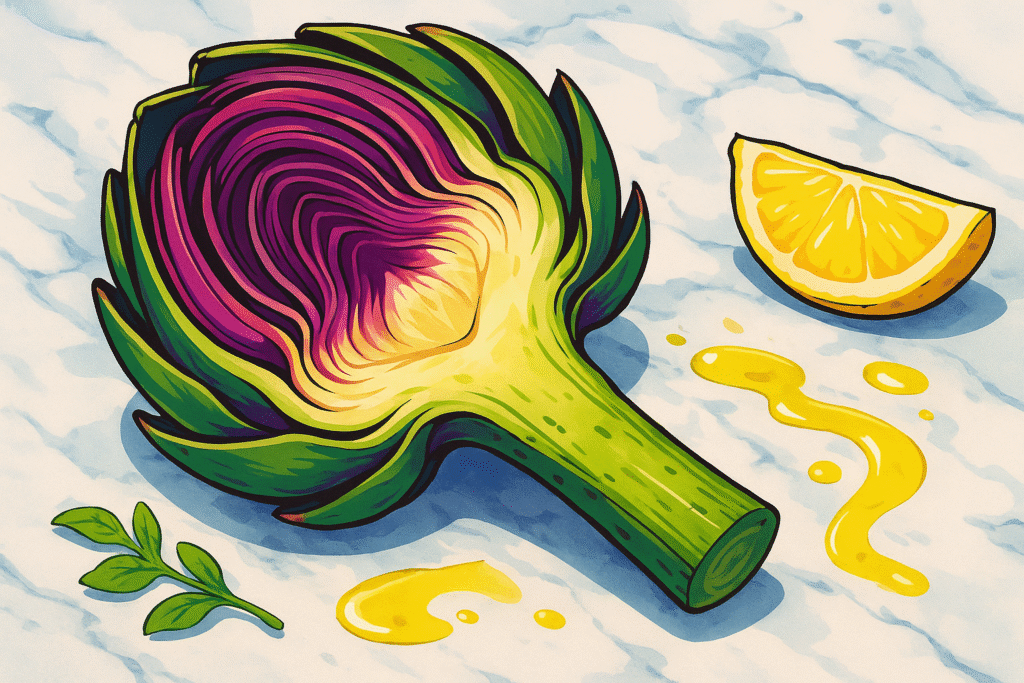Artichoke (Cynara cardunculus var. scolymus)

About Artichoke
The artichoke is a thistle in disguise — a tight-packed bud with armored leaves concealing a tender heart. Its flavor is nutty, grassy, and slightly metallic, especially when steamed, grilled, or preserved in oil.
It’s more than just a side dish; artichokes are central to Mediterranean cuisines and often appear in antipasti, pasta, dips, or eaten leaf-by-leaf with vinaigrette.
The History of Artichoke
Native to the Mediterranean, artichokes were cultivated by the ancient Greeks and Romans, valued for their digestive and medicinal qualities. They evolved from the wild cardoon and were refined into the globe artichoke we know today.
In the Middle Ages, Arab agriculturalists helped preserve and spread the plant across North Africa and southern Europe. By the Renaissance, they were considered luxurious and aphrodisiacal — even banned from consumption by women in some places.
Artichokes eventually reached the Americas via French and Spanish settlers and now flourish in places like California and Peru.
The Science of Artichoke
Artichokes are rich in cynarin, a compound that enhances sweetness — especially noticeable after drinking water. They also contain inulin, a prebiotic fiber that supports gut health.
The edible parts include the fleshy base of the bracts (leaves), the heart, and sometimes the tender inner stem. The fuzzy center — known as the “choke” — must be removed before eating.
The Geography of Artichoke
Italy, Spain, and France lead in artichoke cultivation, particularly around the Mediterranean basin. In the U.S., California’s Central Coast grows almost all domestic artichokes, especially around Castroville.
Altitude and soil can influence size and tenderness. In Peru and Argentina, artichokes are grown for canning and export, while in Morocco and Egypt, they’re a common fresh market crop.
Varieties of Artichoke
Globe
Large, round, and meaty — the classic variety for steaming and stuffing. Thick bracts and a generous heart.
Violetto
An Italian heirloom with purple-tinted leaves. Tender and slightly sweet, often grilled or marinated.
Castel
Popular in French markets, with tightly packed heads and a delicate flavor. Good for fresh eating.
Imperial Star
Bred for climates with shorter growing seasons. Produces harvestable artichokes in the first year.
Green Globe Improved
A commercial favorite with uniform size and flavor. Known for disease resistance and adaptability.
FAQs All your questions about Artichoke: answered
Can you eat raw artichoke?
Yes — young, tender artichokes can be thinly sliced and eaten raw in salads. Most require cooking to soften the fibers.
What’s the “choke” in an artichoke?
It’s the fibrous inner part that becomes the flower’s bloom. It must be removed before eating in mature artichokes.
Are canned or jarred artichokes good?
Absolutely. While they lose some texture, jarred artichokes are great in antipasto, pasta, or dips.
Why does water taste sweet after eating artichoke?
That’s thanks to cynarin, which alters taste receptors and makes water taste unusually sweet.